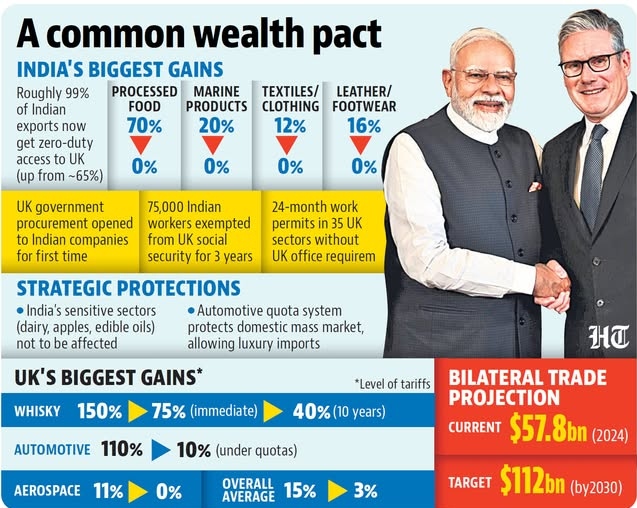PREVIOUS
India and UK - Vision 2035
July 29 , 2025
11 hrs 0 min
35
0
- Prime Ministers of UK and India launched the India–United Kingdom (UK) Vision 2035 in London.
- The plan is a 10-year roadmap to strengthen cooperation in trade, technology, defence, education, and climate.
- This announcement came right after signing the India–UK Free Trade Agreement (FTA), called the Comprehensive Economic and Trade Agreement (CETA).
- The FTA aims to increase trade between the two countries from US$56 billion to over US$100 billion by 2030.
- Vision 2035 sets clear timelines and regular reviews to monitor progress.
- India and the UK will boost cooperation in renewable energy, health, financial services, defence manufacturing, and creative industries.
- They will create platforms to encourage business talks and support the infrastructure investments, including the UK–India Financial Partnership.
- Innovation is a key focus, with plans to establish a UK–India Artificial Intelligence (AI) Centre.
- Both countries will work together on quantum computing, cybersecurity, biotechnology, semiconductors, and space research.
- These efforts will be guided by the Science and Innovation Council.
- The two nations will collaborate on clean energy projects like hydrogen, battery tech, carbon capture, offshore wind, and small modular nuclear reactors.
- These initiatives are part of the Net Zero Innovation Partnership.
- India and the UK will work on reforming global trade rules at the World Trade Organisation (WTO).
- They also plan to improve air travel links and increase tax transparency between the countries.
- India did not get an exemption from the UK’s Carbon Border Adjustment Mechanism (CBAM).
- Starting January 2027, CBAM will tax imports with high carbon emissions, such as steel and Aluminium.
- This could impact Indian exports worth about US$775 million.

Leave a Reply
Your Comment is awaiting moderation.


